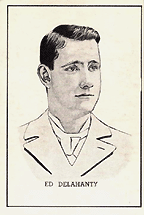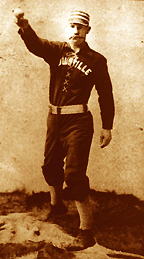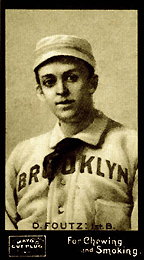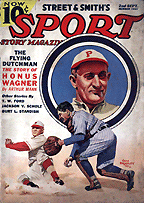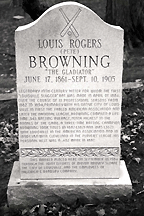

Bat or no bat, the 1884 campaign was a good one for Pete, both on and off the field. On May 12, while the team was on the road, he underwent ear surgery for the first time for mastoiditis. Freed at least temporarily from the mastoidal pain, Pete played in 103 of 108 games without any major alcohol-related incidents, and ended third in the league with a .336 average behind first basemen Davey Orr of the Mets and Long John Reilly of the Red Stockings. Once again he split his time between the infield and outfield.
The Eclipse went 68-40, good for a third-place finish. Hecker had a remarkable year, taking the pitching Triple Crown with 52 wins, 385 strikeouts, and a 1.80 ERA. Hecker’s victory total would stand as the highest single-season mark in AA history, and third all-time behind Hall-of-Famers Old Hoss Radbourne (60) and John Clarkson (53). On October 6, 1884, Pete made his lone career start. Pitching one-third of an inning, he gave up two hits, three runs, three walks and one wild pitch in a 7-6 loss to Baltimore.
The 1885 season found Browning switched permanently to the outfield. He notched his second American Association batting championship, running away with the title (an average of .362 to Orr’s .342). In his blockbuster season, he also captured league leaderships in on-base-percentage (.393), hits (174), and total bases (255). Signature games included a single, triple and home run on May 20; three doubles and a triple in a June 1 contest; a five-for-seven performance on July 10; a trio of four-for-five games on July 16, 21, and 26; and a five-for-five game on August 11.
The Colonels, as they were now known, dropped to 53-59. Hecker saw his victory total drop by 22, and the only Louisville batter giving Pete much support was outfielder Jimmy “Chicken” Wolf.
Hecker bounced back in 1886, most notably as a batsman. In a spirited race for the AA batting title, he held off Pete .341 to .340 (.3411078 to .340471). Pete thus became the only man to lose a batting championship to a pitcher.
Hecker’s work also included a 26-23 mound slate; clearly, the team got its money’s worth. The Association expanded its schedule in ’86, prompting the team to rely heavily on young and unproven Toad Ramsey as its number-one starter. He responded with 38 victories against 27 defeats. Despite the pitching heroics of these two, Louisville failed to play .500 baseball and finished in fourth place.
The major prize of the 1886 season for Pete was his first career cycle, in an August 8th home contest against the New York Metropolitans. The Colonels won 11-6, as he went four-for-five and scored twice off New York’s Jack Lynch. Pete had a single in the first inning, a double in the third, a triple in the sixth and a home run in the ninth.
Sandwiched around the cycle were three items that were vintage Pete. On June 20, his signature appeared in the Courier-Journal as proof by him that he could write. However, both his first and last names were misspelled!
In early July, he was laid off for a month because of “incompetent playing,” an absence that undoubtedly cost him the batting title. And, in a September home contest against St. Louis, which the Louisvilles won 8-2, something happened to Pete which a century later would serve as the lead in a mid-March, 1986 Sports Illustrated article on the centennial anniversary of The Sporting News. Leading off first base, Pete had his attention diverted. Seeing this, pitcher Dave Foutz ran over and tagged him out. To date, it remains the only documented case of a hurler picking off a runner unassisted without the benefit of a rundown. About seven thousand fans witnessed the play and the game, which was umpired by Mr. "Kick" Kelly.
A
year later Pete found himself on the short end of another batting race,
this despite one of his finest seasons. It isn’t often a player
can hit a career-best .402, and wind up second—a distant second.
But that is exactly what happened in 1887 as Tip O’Neill hit .435
for the St. Louis Browns, who ran off with the AA pennant for the third
year in a row. Lost in the shuffle were career-bests by Pete in hits (220),
slugging average (.547) and on-base percentage (.464). In compiling the
second highest average ever in a single season (bettered only by Hugh
Duffy’s .440 mark with the Baltimore Orioles), O’Neill also
became the only player in major-league history ever to lead a league in
batting, hits, total bases, slugging average, runs, doubles, triples,
home runs, RBIs and on-base percentage.
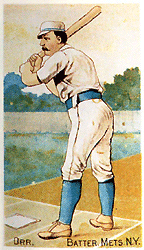 |
As one would expect, Pete had a number of emblematic games, the best easily being three near cycles: a single, double and a triple in a 16-1 demolition of Baltimore at home on August 20; a single, double and two triples on September 3 in a 14-9 loss at Brooklyn; and a double, two triples and a home run on September 6 in a 12-11 road victory over the Metropolitans.
The Colonels righted their ship and posted a 76-60 record, good for third. Browning got help from fellow flychasers Wolf and Hub Collins, as well as third baseman Joe Werrick. Ramsey had another big year as Louisville’s top hurler, while Hecker and 19-year-old Elton Chamberlain split most of the remaining starts and notched 18 wins apiece.
In 1888, baseball ended its one-year experiment counting walks as hits, and as a logical consequence averages and ERAs plummeted. Pete’s .313 mark, however, was more the product of an extensive suspension, and less the product of the two major rule changes. (The other was the restoration of the three strikes-and-out rule.) The time off undoubtedly cost him a higher finish, maybe even the AA batting championship. That went to O’Neill in a repeat performance, his .335 work being followed by Long John Reilly (.321) and Pete.
The hiatus was in direct contradiction to an April 17 temperance pledge Pete made to nationally-known evangelist Francis Murphy at Eclipse Park. Initially, the penance paid dividends. A week later, he went five-for-five (all singles) in a 15-6 win over the Kansas City Cowboys, part of a two-month run that included nine other signature games, the kind of foundation upon which batting crowns are built.
The wheels began to fall off on June 19. With the Colonels in Kansas City, Pete got roaring drunk and landed up fishing in the gutter outside the team’s hotel. The drinking escalated, and in late-July he was temporarily grounded with biliousness (a liver dysfunction in which the organ secretes excessive amounts of bile). More good games ensued, but the erratic behavior of its star player finally took its toll on Louisville management.
After missing a game on August 10 with a stone bruise on his heel, Pete was suspended a second time and did not make an appearance again until September 23, when there were only three weeks left in the season. The offense, towering even by Pete’s standards, more than justified the suspension. According to a late-August story in the Louisville Courier-Journal, Pete—drunk and sporting a black eye of unknown, and sans a shirt, vest or undershirt (his bare chest being covered only by a overcoat)—had boarded a streetcar and insulted a city councilman, whom he later dragged into a saloon.
The Colonels staggered home, too, finishing only two losses better than the last-place Cowboys.
Louisville’s downward spiraling star finally hit rock-bottom in 1889, when Pete batted a career-low .259. His average was a reflection of the doomed season which saw the Colonels finish in the cellar with a 27-111 record—66 games back of league champion Brooklyn Bridegrooms. The team’s misery included 26 consecutive losses (still the all-time major-league record), arbitrary fines and pay dockings by owner Mordecai Davidson, four different managers, the takeover of the club by the league (followed by the sale of the Colonels), a close call with the lethal Johnstown Flood, and even a brief players strike—the first ever in major-league history—the participants of which included Pete.
Oddly enough, Pete
picked up his second career cycle on June 7, his five-for-six day including
a pair of singles and two runs scored. Remarkably, the effort came during
the ferocious losing streak. Even more remarkably, the feat had been accomplished
from the sixth spot in the lineup. All of this came to naught, as the
Louisvilles lost 9-7 to the Philadelphia Athletics, their 14th straight
defeat. For Pete, the season ended abruptly on August 11 when he was suspended
the remainder of the campaign (a career-best two months) for drunkenness.
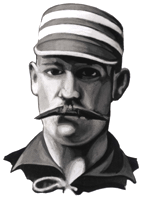 |
Whether it was chronic alcoholism or mastoiditis-generated pathological drinking will never be fully known. Considering Pete’s success the remainder of his career, in particular the next season, it was more than likely the former. One thing was without question, however. Left in the wake of Pete’s most self-destructive season were two abstinence pledges he had signed in early April, one with Davidson and another before a local judge.
In 1890, for the second time in its history, major-league baseball presented fans with three leagues, the new addition being the Players League. Among the more than two dozen stars jumping to the Brotherhood was Pete, who joined the Cleveland Infants. His teammates included hard-hitting first baseman Henry Larkin, and a couple of emerging stars who defected from the National League’s Cleveland Spiders, Ed Delahanty and Patsy Tebeau. Despite this confluence of talent, the Infants sputtered to a 55-75 record and a seventh-place finish.
Ironically, the lowly Colonels went from worst to first in the AA. The team’s talent, such as it was, had been left in tact save for Pete. When the juggernaut Bridegrooms moved to the NL, Louisville won the pennant.
Had it not been for Pete, meanwhile, Cleveland’s 1890 season might have rivaled the '89 campaign at his former address. Signed for a hefty $4,480 (according to one source), he responded in price, taking the first, last and only batting title of the Players League with a .3732 average, which just barely nipped Davey Orr’s .3728 work. Also the league leader in doubles with 40, Pete finished second in on-base percentage (.459), fourth in hits (184), and fifth in slugging percentage (.517).
A change of scenery often produces excellent results, and in retrospect, Pete’s '90 campaign was high baseball art. At the age of 29, he put the final touches and flourishes on a magnificent career with one final, grand masterpiece.
The season, however, wasn’t just all hitting. There was also the matter of Pete’s glove, and on Friday, June 6, 1890, the Cleveland Plain Dealer carried arguably the best story of his career, one which thoroughly debunks the long-held perception of him as a one-dimensional player who was “good hit, no field.”
Headlined “In Love With Old Petie”, the Plain Dealer article contained pickups from two leading Chicago newspapers: “Pete Browning has made an unconditional ‘hit’ in Chicago and people there have gone wild over the Gladiator’s ball playing.”
Describing a play in the June 4 game, the Chicago Inter Ocean said: “The one act of the afternoon which stands out like a wart on a man’s nose was a catch by Col. Browning in the fifth inning. Mr. (Hugh) Duffy, a distinguished townsman with whom it is a genuine pleasure to deal, tripped to the bat with his teeth set so hard that his jaw bones stuck out like handles on an Etruscan vase. He reached for the first ball which Mr. (Jersey) Bakely was good enough to land over the rubber.
“The sound that followed was the same as when the slats fall down in an old-fashioned bed. The ball mounted towards the town of Jefferson until it was lost to sight. It came into view again in a few moments in the extreme left field, and then it was observed that Mr. Browning was only a few rods away.
“He rattled his lengthy legs towards his heart’s desire as long as possible, and then jumped in a northwesterly direction, turning four times in the air and stretching one arm for the ball in a manner of a boy after his second piece of pie.
“He got it.
“Then applause went up from the grandstand like an insane man experimenting with a French horn. Pete had to doff his cap a dozen times.
“Of the same play, the (Chicago) Tribune says: Browning was the hero of the day. He made one of the most marvelous catches from Duffy’s bat ever see on a ball field.”
This Browning sparkler was no isolated example. Rather, it was reflective of the defensive work that spanned his entire active career—from a rookie game in 1882 when he posted six putouts, five assists and two double plays (at either shortstop or second base) to the opener of a July 4, 1893 doubleheader at home, in which Pete made “probably the grandest catch that has ever been made in this city.”
Numerous other reports
of his fielding heroics can be found in the papers of the day. Clearly,
when Browning was “on”—that is, not beset by illness,
injury, pain or alcoholism—he was capable of the most extraordinary
web gems, a virtuoso along the lines of Willie Mays. When he was “off,”
he was perfectly suited to be a DH. Seemingly, there was no in-between.
Unquestionably, Pete’s alleged defensive liabilities can now be traced to three separate entities: historical embellishment, ignorance of his times when the crude equipment made anyone fielding at .950 or better a golden glover; and the contradiction that Pete for a good portion of his career played the three most significant positions on the defensive spectrum—shortstop, second base and centerfield, hardly places where a defensive liability would be put.
The June 6 Cleveland Plain Dealer article piece also shows how much cities around the circuit like Cleveland and Chicago loved Pete (and certainly, he them in return). And that leads directly into another salient historical point, overlooked by numerous historians, researchers and baseball writers over the years: the inordinate joy that Pete brought to countless thousands of fans all during his career. Nine days later, the Cleveland Plain Dealer carried this short item, which iced the cake of the June 6 article: “President Addison of Chicago is opposed to Peter Browning on principle. ‘That fellow,’ he says, ‘is seven feet high and he jumps six feet into the air to pull down home runs. What does he want to do? To kill the sport off entirely?’”
In retrospect, the weakest part of Pete’s game was not his fielding, but his baserunning. The examples of his gaffes on the basepaths are endless and legendary, the most notable of all in the 1886 game when Pete was the victim of the unassisted pickoff by Dave Foutz.
The 1891 season marked Pete’s third different league in as many seasons, and his first in the National League. In hindsight, it is easy to state that had it not been for the 1877 Louisville pennant-fixing scandal, Pete would have probably spent the bulk of his career in the senior circuit instead of his twilight years. (Without question, he would have increased his career numbers and would today be in Cooperstown.)
Splitting the season between the Pittsburgh Pirates and the Cincinnati Reds (the NL’s two worst clubs), Pete wasted little time in adding to his legend, bunting into a 4-6-3 triple play against the Chicago Cubs on May 5. Though a freak play, it was a sign of things to come.
While hitting decently, Pete began to run afoul of manager Ned Hanlon over such things as wearing spikeless shoes, which caused him to fall down while chasing a flyball. On another occasion, he hit into a double play after ignoring Hanlon’s orders to sacrifice. As a consequence, Pete and his .291 average were sent packing in late June.
He was quickly picked up by the Reds, for whom he batted .343 in 55 contests. While there, he ran into a mirror image of himself, teammate Long John Reilly, whose obsession with “hit-filled” bats was second only to The Gladiator’s. It was suspected but never proved that while Pete was conducting an early-July interview in one part of the clubhouse, the covetous Reilly was in another section picking up a few good sticks.
Pete’s last fine game of the season came on September 2 when he singled twice and tripled once in four trips to the plate. Three days later, he was done for the season when Kid Gleason came far inside with a pitch that Pete fended off with his hand to avoid being beaned.
It is reasonable to believe that, had Pete spent the entire season in Cincinnati—and remained injury-free—he might have become the first and only man to win batting crowns in three different leagues, the kind of major-league history that would have guaranteed him a spot in Cooperstown. He ended up with a .313 mark that was third behind Billy Hamilton (.340) and teammate Bug Holliday (.319).
In 1892, for the first time in a decade, major-league baseball found itself with only one league, the Players League having folded after the 1890 campaign and the American Association closing shop in 1891. Back with his old city, Pete hit .247 in 21 games for the Louisvilles before being released in mid-May. Once again, he caught on quickly with Cincinnati, batting .303 for the Reds in 81 games and ending the season at .292.
Pete’s top game
was a five-for-six performance (all singles) against Baltimore in early
July, but his sloppy defense (trying to stop grounders with his shins)
earned him his release shortly thereafter. Cincinnati re-signed him toward
the end of the year, and on September 2 he rewarded the Reds with a three-for-four
effort. A few days later, Pete left a game following an attack of vertigo,
the manifestation of his mastoid problems.
The next year found Pete back in Louisville after signing a contract in late May. He delivered on both sides of the diamond, playing sterling defense and hitting well over .300. No doubt aided by the moving back of the pitching rubber from 50’ to 60’ 6”, Pete was still a marquee player. Among the league leaders with a .355 average, he was inexplicably released in early August, and played no more that year.
Pete caught on briefly with the St. Louis Browns in 1894, then made his way to Brooklyn, where he was hired by a familiar face, player-manager Foutz. True to form, Pete’s fabled major-league career came to a close with a storybook ending. On Sunday, September 30, 1894, in the finale of a closing-day doubleheader, he played right field for Brooklyn and batted sixth in the order. The Gladiator singled twice in two official at-bats, walked once and scored once. The work helped Brooklyn to a 12-4 victory and a split in the twin bill…held in Louisville.
In early June of 1895, Pete played first base for a local team, the Rhodes-Burfords, and led them to a 26-11 smashing of the Rudolphs & Bauers. Obviously, the round-trip train ride was headed home after a lengthy series of stops: amateur prodigy, major-league rookie sensation, longstanding major-league superstar, major-league journeyman, and then finally an aging ballplayer holding back the dawn as a minor-league, semi-pro and amateur fill-in player. Officially, the last stop came in 1896, when Pete logged his last recorded season of organized baseball at any level, batting .333 in 26 games with Columbus of the Western League.
The late 1890s found Pete working as a cigar salesman—his bar (located near his residence at Thirteenth and Market) having failed, perhaps for the most obvious of reasons. Giving that up, he turned to caring for his mother, and during the baseball season, Pete was seen frequently at local games. As in previous years, he was always well-received and well-remembered by crowds.
Alas, the peaceful retirement was an optical illusion. On June 7, 1905, according to existing court records stored in Frankfort at the Kentucky State Archives, Louis Rogers “Pete” Browning was produced in the criminal division of Jefferson County Circuit Court where he was declared insane and ordered to the Fourth Kentucky Lunatic Asylum at nearby Lakeland.
As a matter of course, the Courier-Journal story the next day recounted Pete's prowess as a hitter, and also rrelated his secret for his batting success: daily washings of his eyes with buttermilk. Even under the direst of circumstances, Pete was extraordinarily readable copy.
After some improvement, he was removed from Lakeland by one of his sisters on June 21, 1905. Then, on July 26, Pete was admitted to old City Hospital, later renamed General Hospital and now called University Hospital. There he underwent surgery for ear trouble and a tumor of the breast on July 29. Making a rapid recovery, The Gladiator was sent home only to return in early August after experiencing more difficulty. Becoming morbid and losing hope, Pete refused to take his medication or cooperate with doctors.
In late August, he
slipped away from the hospital and walked to his mother’s house,
explaining that he didn’t like to hear people groan. That same night,
he was taken back to the municipal hospital.
On September 1, 1905, Hillerich & Bradsby signed a contract for its first autographed model with future Hall-of-Famer Honus Wagner, who had begun his career at Louisville in 1897 along with another Cooperstown resident-to-be, pitcher Rube Waddell. The first man to have his name on a bat, Wagner was part of modern endorsement advertising history.
Wagner was also part
of a nucleus of four players transferred to Pittsburgh after Louisville
lost its franchise when the National League contracted from a dozen teams
to eight clubs following the 1899 campaign. The results were startling
and immediate. Led by former Louisville standouts Wagner, Deacon Phillippe,
Tommy Leach and another future Hall of Famer, Fred Clarke, the Pirates
became a dynasty, winning four pennants (1902-03-04-09) and one world
championship (1909) over the next decade.
As those new stars began to rise and shine, however, an ancient star—and
the catalyst for all of that history—began to dim.
Around the time of Wagner’s historic contract, a growth appeared once again on Pete’s neck. Deteriorating rapidly, he finally yielded to his relentless adversaries at 2:15 on Sunday afternoon, September 10, 1905. Present during the waning hours of the final siege were his mother, Mrs. Mary Jane Sheppard Browning; two sisters, Mrs. Florence Ramsey and Miss Fannie Browning; and one brother, Charles. Another brother, Henry, was unable to come to his bedside because of serious illness.
This scene is in direct contradiction to a commonly reported error that Pete died alone in an insane asylum. (Great story, especially if you’re a Hollywood screenwriter, but that’s all it is.) In truth, the end for Pete came simply and without any earthshaking fanfare, at a city hospital surrounded by members of his family. Nothing more.
Pete’s medical problems were substantial. Beside the brain damage sustained by both the crudely-treated mastoid condition and years of acute alcoholism, he had cancer. And most certainly, Pete was suffering from cirrhosis of the liver, another byproduct of his years of wild, unchecked and lethal drinking. (Besides the Gladiator, Browning was also known as “Pietro Redlight District Distillery Interests Browning.”)
Funeral services were
held the following afternoon, Tuesday, September 12, at the home of Pete’s
mother. From there, he was taken to Cave Hill Cemetery, the final resting
place for many of Louisville’s major-league ballplayers, as well
numerous nationally prominent local and state figures. Pete’s old
outfield mate, Jimmy Wolf, had been interred there two years earlier.
Serving as Pete’s pallbearers were John Dyler, his first manager,
and a number of former teammates including John Reccius and Tom McLaughlin.
Pete’s gravesite was marked by a plain, simple granite gravestone.
The Browning name lived on through baseball anecdote and legend. One of Pete’s nephews, Tod Browning, went on to gain fame as a Hollywood director. Among his credits is the horror classic “Dracula,” starring Bela Lugosi.
On September 10, 1984, on the 79th anniversary of Pete's death and during the centennial year of the Hillerich & Bradsby Company, the world's most famous batmaker joined with the city of Louisville to honor Pete with a new grave marker that correctly spelled his name and fully detailed his lifetime baseball achievements. Around this time, evidence was uncovered that finally brought the severity of Pete’s heartbreaking battle with mastoiditis to light.
A complex three-tiered figure, Pete endures to this day as a transcendental mega-star known even to those with a cursory knowledge of the game; one of American baseball’s most colorful pieces of folklore; and a timeless, horrifying human tragedy.
All that’s missing from the story now is a plaque for Pete in Cooperstown.
